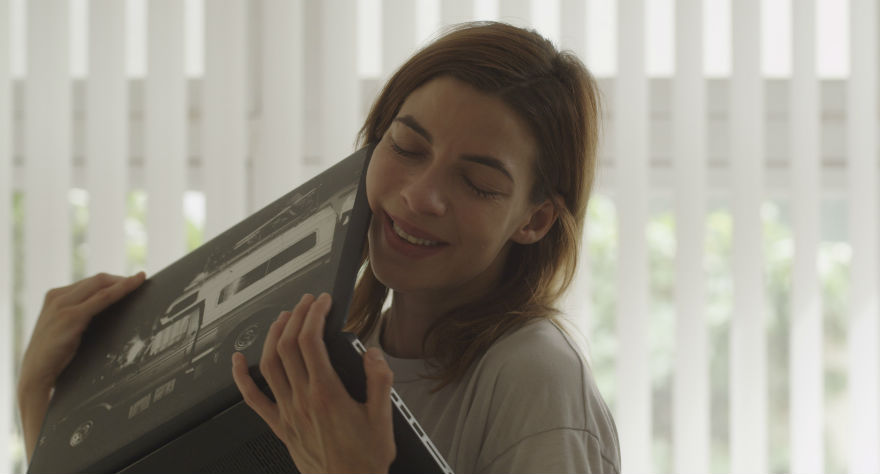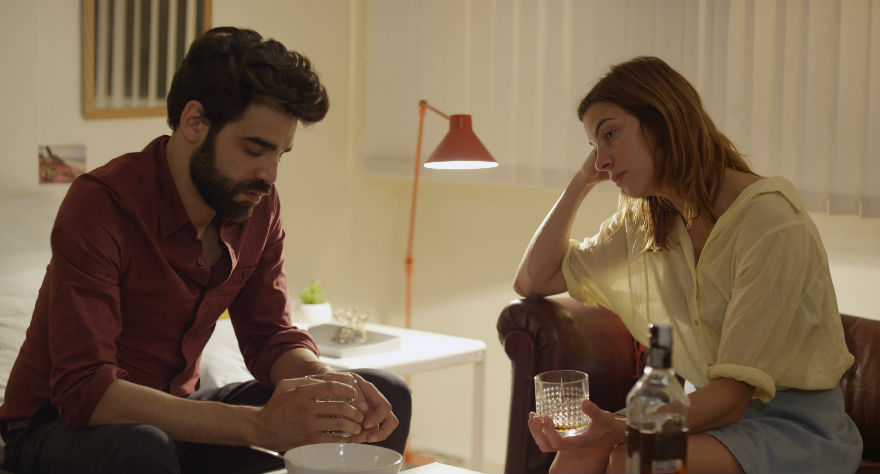Carlos Marques-Marcet On ‘10,000 KM,’ the Art of Body Language

In Carlos Marques-Marcet’s 10,000 km, a terrifically acted love story set in the digital age, we follow a couple jumping headlong into a long distance relationship in which technology is the only tether between them. Sergi (David Verdaguer) stays in the couple’s apartment in Barcelona while his girlfriend Alex (Natalia Tena) moves to Los Angeles for a year to further her art career. The story takes place entirely within Sergi and Alex’s respective apartments in Spain and the U.S. as we watch their Skype calls, read their text messages and watch one of them snoop around on Facebook
It’s an incredibly bittersweet movie that conveys perfectly how, despite all the different avenues of communication technology affords us, it actually amplifies the anxieties that come with geographical separation when you’re in love with somebody. It’s the best love story I’ve seen this year.
I spoke to Carlos about the film, which hits San Francisco tomorrow.

I thought the movie’s sound design was done very well.
It’s funny. Nobody has talked to me about it much, but I’m very obsessive with sound. It’s 50 percent of your movie. We shot in Barcelona—the part in Los Angeles, too—so we really wanted to create a soundscape to reflect the whole city just staying in these two rooms. We spent a lot of time recording sounds in Barcelona and Los Angeles. My sound designer researched all of the birds that fly through in every time of the year.
Really? Wow.
At this point, I’m obsessive. Of course nobody’s gonna know. Maybe bird specialists, but not even. But I think it’s these kinds of things that give you that feeling. You don’t know why, but it feels like Los Angeles. It feels like Barcelona. The most important thing was to create this off-screen space. Really minuscule stuff. There’s the sound of the butano gas people who make this *klink klink* sound as they go around outside in Barcelona. Also, it’s important to me to play with the quality of the image and sound. We knew every scene would have a specific sound to the [voices]. Basically, we recorded Skype on both sides so we’d be able to mix how we wanted. [We could make them sound] more metallic or closer as much as we wanted. There are scenes where you start with a very Skype sound, and then they start sounding closer to their natural voices. It’s something you shouldn’t realize; it creates a feeling rather than take attention for itself. You can feel how the characters feel, through the sound.
Another thing we did, if you see it in theaters, is something you almost never do. We played with the surround sound so that the voices come out [from different directions]. You can’t do that with a normal scene—the sound should come from the center, the screen, so that you won’t get distracted by voices coming from somewhere else. But in that scene, when you have the full Skype thing, you feel like you’re actually inside the computer, between the two actors.
Who are some sound designers or filmmakers you look up to?
There’s always Walter Murch as an editor and sound editor. He’s amazing. You can hear any of his music, and it’s like, “Wow!” I’m not a super Terrence Malick fan like my friends, but his sound is unbelievable. You can listen to how specific he is; he does that same thing with the birds. His narrative and images are a bit too much for me, but the way he uses sound is spectacular. There are more classical sound people, like Bresson and Tati. I like to use a more subtle approach to sound, but it’s pretty much the same function.
I read something you said that fascinated me. You said that, when people speak, we typically say much more than we intend to, as if language exists outside of us.
My mother is a psychoanalyst. For most people, psychoanalysis is something you read in a book or something or go to Brown to study. In my case, it’s something I grew up with, so it’s not a very theoretical approach to things. It’s something I experience. We sometimes think that we have thoughts in our mind, and then language transforms them and brings them out and you communicate them. But I feel sometimes you don’t have thoughts until you speak them. That happens very often. When you’re talking, you’re realizing things you didn’t know were there. It’s something created in the process of talking and associating ideas that’s unconscious.
The unconscious is not something that’s so deep. People have this idea that it’s about your mother and father and deep thoughts of killing and things like this. To me, psychoanalysis and Oedipus is a tale to explain how language works and how we function in these structures our minds are built with. It circulates when we begin to communicate, and it’s very tangled. The emotional and the rational aren’t separated. We think because we feel and we feel because we think.
We live in language. When you see a Béla Tarr movie that’s supposed to be non-language, you still see a woman and a man eating potatoes. You have these signs, somehow. You have a social lecture of this, and it brings you to all of these memories of the apocalypse and all these ideas. It’s language. Even if it’s with images, it’s storytelling. We cannot disassociate images and language.
There’s the kind of person who would say that, narratively, not much happens in your film, or in a Béla Tarr film. It frustrates me, because I know there’s a lot going on there—it’s just not spoken by the characters verbally.
I love films that aren’t very narrative. Sometimes I feel like my films are too narrative! [laughs] It’s well-plotted, even if it’s hidden. It’s actually a very classical structure, with three acts. It’s like a classical Hollywood script, if you look at it. It’s presented in blocks. It’s something I try to avoid sometimes, but I just fall into it. I’m very classical in the way I make movies. I did a short of my little cousin kicking a can. Years later, when I learned about the three-act structure, I saw that I just fell with A,B,C,D. It’s just a kid coming home from school, kicking a can. It’s am minimalist adventure film. He finds something on the way, he takes the trip seriously. It’s a hero’s journey. It’s just a kid kicking a can, but in the end, it’s a very classical structure.
I admire my filmmaker friends who go out there and try different things. Inherent Vice, to me, is all plot! [laughs] It’s just the plot doesn’t make any sense, in a good way. I feel like it’s a response to all these people you mentioned who say, “Nothing happened.” Okay. Here’s a movie where lots of things are happening, but it doesn’t mean shit! It’s not about things happening; it’s about it having an arc. I think people misunderstand storytelling and structure. There’s many ways of doing it. Michael Snow is one of my favorites, but he’s very classical at the same time. He makes experimental films that are very narrative; you have repetition, variation. Sometimes narrative is more complex than “things happening.”
I think a lot of your film’s story is communicated through David and Natalia’s body language.
That was actually our starting point. I took dancing classes to prepare for the movie. I was tired of working with the actors through motivation. I wanted to work physically. I was learning a lot of somatic techniques to try to figure out other ways to work with them. We started working with the actors just physically. Dancing was a big component of the movie. Dancing and sex are the two most intimate things a couple can do, I feel. We rehearsed a lot. Every day, before rehearsals, we’d spend half the day doing dancing exercises. I made them do a strip-tease to become comfortable with each other. We were trying to feel out who these people are. When you’ve been with someone for seven years, you have a body language that has a history. We had to find a way to compress this seven years into a week or two weeks! We had to make it feel specific, the way they touched each other.
The last scene is killer. What was it like shooting it?
It was so hard. People ask if it was difficult to do the first scene. That first scene was preparation. I was terrified of the last scene. Terrified. It’s funny, the night before shooting, I watched a lot of sex scenes. [laughs] I was like, “I don’t know what to do!” I had three days to shoot it, and I kept postponing the ending of the scene. The third day, my AD was like, “Carlos, you have eight hours. Carlos, you have six hours. Carlos, you have four hours.” So I had to. Even during rehearsals, I didn’t want to rehearse the ending, but my actors insisted. I couldn’t watch it! They were rehearsing having sex, and they look back, and they’re like, “Where’s the director?!”
It was crazy, because it was happening. We just jumped into it. The actors weren’t blocked because they’d been together for a while. It was very, very intense for the team. The DP was getting married, so a taxi was waiting at the door of the house to go to the airport! It was our last chance. I gave a couple of directions, and the magic happened. But we were very close to not having an ending. It was like a miracle at the last moment.
You get pretty inventive with how you use technology as a storytelling tool. Were there any ideas that didn’t make it in?
Of course. One of the things I had to cut that I really liked was, there’s this element when you talk on Skype or any video chat: you can’t look each other in the eye. There was this moment in the beginning where they’re trying to look at each other, but they can’t, because when you look at the screen, you’re no longer looking into the camera, and when you’re looking at the camera, you’re no longer looking at the person on the screen. It’s the impossibility of looking into each others’ eyes.
